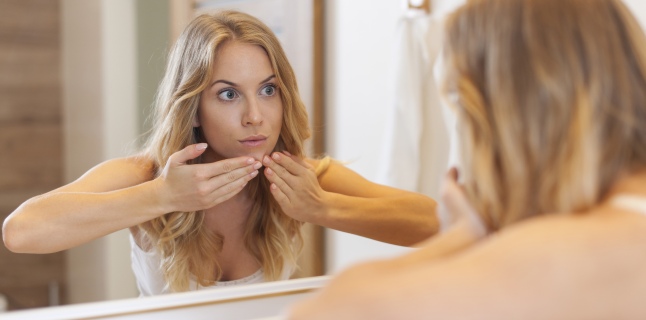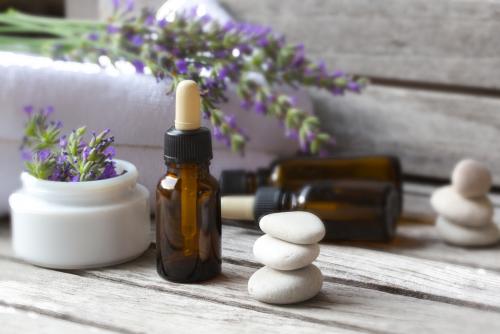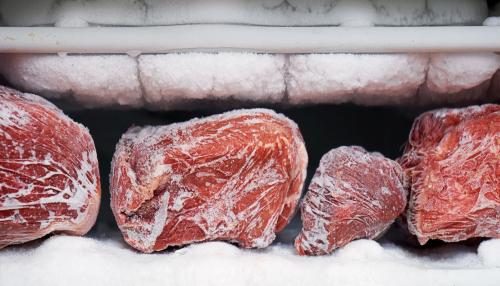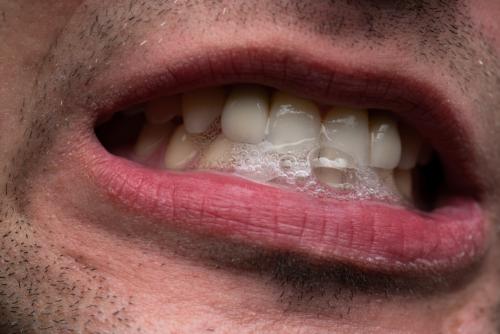Acne, an ageless condition

The factors involved in acne are: - Genetics: Acne occurs more frequently in inherited seborrheic youngsters whose parents have experienced acne lesions. - Increased sebum production under control. It either excretes excessively during puberty, or sebaceous glands have a higher receptivity to testosterone. - Abnormalities of microbial flora: the skin is populated with bacteria and fungi developed on seborrheic background. - Keratinization disorders with tendency to form some (black spots) or cysts. It prevents the release of sebum from the level, with its accumulation, with a secondary inflammatory reaction.
- Some pathological conditions in women with excess hormone production in the ovaries (in the presence of ovarian cysts) or adrenal glands (in). Acne lesions are located in seborrheic areas, especially face, cheeks, forehead, chin, but also on the upper chest area both anterior and posterior, on the shoulders. The age of appearance is generally between 13 and 17 years, earlier in female sex, but there are forms that can begin after that period. Early onset of acne can be correlated with the occurrence of hormonal disturbances, especially in the genital area, associated with menstrual cycle disorders. The evolution of acne is in bloom, with periods of aggravation and improvement (improves the eruption, stress may worsen).
The lesions are localized as follows: face 90%, back 60%, chest anterior 15%. Clinical forms (after predominance of the type of lesion): • Comedone acne: comedones predominate, both open comedones (black spots) and dark comedones (white spots). It occurs in puberty, can be aggravated by various cosmetic mistakes and is usually associated with seborrhea, originally located on the nose, then forehead, cheeks. • Papulo-pustular acne: Follicular papules are small protruding red, painful, superficial. Superficial follicular pustules result from the evolution of inflammatory papules, taking the clinical appearance of papulo-pustules.
It shows up a purulent collection that is eliminated after 4-5 days. • Nodulo-cystic acne occurs more frequently in men, with multiple deep lesions located on the face and upper chest, on shoulders, neck and buttocks. It is a severe form of acne, large, painful inflammatory nodules that become chistic, eliminate a bad smell and cover the crust. • Tuber acne: deep blooms appear. • Furunculoid acne: Appetite nodules appear.
Other clinical forms of acne can be classified according to age, the occurrence of acne lesions or other factors favoring the onset of the disease. - Neonatal acne occurs in the first months of birth and is more common in male sex. - Childhood acne starts at the age of 2 years. - Juvenile polymorphic acne is the most common form of acne. She debuts about a year before setting up around the age of 12 in boys, but there are cases where the onset is 2-8 years earlier or later.
Initially seborrhea occurs, the skin is \. - Adult acne (late) consists of the persistence or reoccurrence and worsening of acne lesions after puberty (even over 30-40 years). A tardive acne poses the problem of ovarian cancer or ovarian cancer if an exogenous cause is excluded (cosmetic acne or a professional maintenance factor). - Progression of acne occurs after discontinuation of treatment with. - Mentholic acne occurs in mature women with localization in the chin area and is very rebellious in treatment.
- Necrotic acne consists of pustulo-necrotic, painful lesions that preferentially locate at the forehead. Let go deep scars. - Keloid acne is a particular form of acne included in the group of staphylococcal aetiology, which occurs more frequently in mature men, located in the neck area. - Endocrine acne occurs in Cushing's syndrome and polycystic ovary syndrome. - Acne-induced external factors: - Cosmetic acne - by inappropriate use of the skin type of cosmetics or after aggressive cosmetic treatments that affect adult women who have had acne in.
It can be fat-induced (appears on the face and is due to the excessive use of fatty \. - Professional oil acne. - Chlorine acne. - Drug-induced acneiform rash (corticoids, anticonvulsants). - Acne scarring - in women with acne lesions associated with self-inflicted lesions - abrasions.
Preventive treatment involves avoiding the use of topical (creamy) or systemic (oral) medicines with acneigenic potential (fatty creams, dermatocorticoids). Curative treatment can be topic and / or systemic. For topical forms, topical treatment is sufficient, and for the medium and severe forms it is necessary to associate to the topical treatment of systemic treatment. Reduction of seborrhea can be achieved either by topical treatment or by systemic treatment. As a topical treatment, it is recommended to remove sebum by frequent washing with antibacterial soap and water and the use of antiseborical lotions or lotions and solutions based on salicylic acid / sulfur.
Systemic treatment consists of estrogen administration. In acne is also used retinoic acid (in gels, creams) or azelaic acid with bacteriostatic effect. To reduce microbial flora antibiotic therapy, both topical and systemic, is administered. Other methods used to treat acne are exposure to, dermabrasion or laser. .
Source : sfatulmedicului.ro
Views : 3153
Popular Article
- (photo) Nude becomes art.
Posted: 2018-03-17, 9587 views.
- The harmful effects of air conditioning on the skin
Posted: 2017-06-08, 8268 views.
- 3 causes of dyed hair discoloration
Posted: 2017-06-15, 8140 views.
- Why early puberty occurs in girls: symptoms, favors, diagnosis and treatment
Posted: 2017-10-24, 7996 views.
- Good or bad skin treatments in the hot season
Posted: 2017-06-07, 7736 views.
Recommendations
- (photo) Nude becomes art.
Posted: 2018-03-17, 9587 views.
- The harmful effects of air conditioning on the skin
Posted: 2017-06-08, 8268 views.
- 3 causes of dyed hair discoloration
Posted: 2017-06-15, 8140 views.
- Good or bad skin treatments in the hot season
Posted: 2017-06-07, 7736 views.
- Risks of practicing sports on hot days
Posted: 2017-06-12, 7329 views.
 4 effective ingredients in the fight against acne.
4 effective ingredients in the fight against acne. How to get rid of hiccups fast
How to get rid of hiccups fast The wheat bran diet: the secret of lost pounds as if by magic
The wheat bran diet: the secret of lost pounds as if by magic The recipe that will sweeten your soul this weekend!
The recipe that will sweeten your soul this weekend!  Is it dangerous or not to refreeze meat after thawing it?
Is it dangerous or not to refreeze meat after thawing it?  The unusual sign of diabetes indicated by saliva.
The unusual sign of diabetes indicated by saliva. What to drink to boost your immune system.
What to drink to boost your immune system. 10 foods that help you never age.
10 foods that help you never age. What actually happens in your body if you drink a cup of coffee for breakfast
What actually happens in your body if you drink a cup of coffee for breakfast 5 surprising benefits of chia seeds
5 surprising benefits of chia seeds